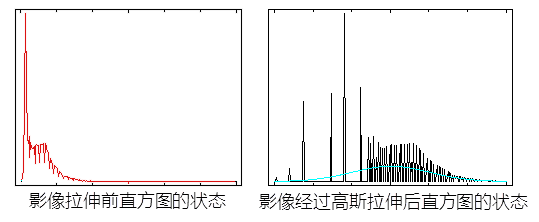com.supermap.mapping
Class ImageStretchType
- java.lang.Object
-
- com.supermap.data.Enum
-
- com.supermap.mapping.ImageStretchType
-
public class ImageStretchType extends Enum
Image stretch type, currently supports no stretch, standard differential stretch and the maximum value of three.
-
-
Field Summary
Fields Modifier and Type Field and Description static ImageStretchTypeGAUSSIANGauss stretch The purpose of Gaussian stretching is to make the pixel values of the image data tend to be normal.static ImageStretchTypeHISTOGRAMEQUALIZATIONHistogram equalization The histogram equalization is the non-linear stretching of the image, reallocating the image pixel values, so that the number of pixels within a certain gray scale range is roughly equal, so that the original histogram in the middle of the peak part of the contrast is enhanced and both sides The bottom part of the contrast is reduced, so that the histogram of the output image is a relatively flat segment histogram; if the output image data segmentation value is small, it will produce a rough classification of visual effects.static ImageStretchTypeHISTOGRAMSPECIFICATIONHistogram match Histogram matching is the mathematical transformation of the image lookup table so that the histogram of an image is similar to the histogram of another image.static ImageStretchTypeMINIMUMMAXIMUMExtreme stretch The maximum stretch is a linear stretch based on the maximum and minimum values of the pixels, using the maximum and minimum values as the two endpoints of the stretched histogram, for example: an image data using an 8-bit memory The pixel value and the range of the pixel values are distributed between 30 and 200.static ImageStretchTypeNONENo stretch No stretch is done without any stretching of the image data, but this absolute non-stretch is actually only effective for image data of an unsigned integer 8-bit storage format.static ImageStretchTypeSTANDARDDEVIATIONStandard deviation stretch The standard deviation is described below by the histogram.
-
-
-
Field Detail
-
NONE
public static final ImageStretchType NONE
No stretch No stretch is done without any stretching of the image data, but this absolute non-stretch is actually only effective for image data of an unsigned integer 8-bit storage format. The image data displayed on the computer is in the range of 0 to 255, so that for image data stored using a non-unsigned integer 8-bit, when the image data is not stretched, A simple linear stretch was made in the range of 0 to 255. When the image data is stored using a non-unsigned integer 8-bit, SuperMap displays its value using the most value for the display, so for a non-unsigned 8-bit image storage format, The effect of the non-stretched image display is consistent with the effect of using the most value after stretching.
-
STANDARDDEVIATION
public static final ImageStretchType STANDARDDEVIATION
Standard deviation stretch The standard deviation is described below by the histogram. As shown in the figure below, the effect of the image before and after stretching can be seen from the histogram. After stretching, the histogram of the image conforms to a normal distribution curve, and the standard deviation of the histogram of the stretched image increases Large, that is, the pixel value of the image data decreases with the mean value deviation.
-
MINIMUMMAXIMUM
public static final ImageStretchType MINIMUMMAXIMUM
Extreme stretch The maximum stretch is a linear stretch based on the maximum and minimum values of the pixels, using the maximum and minimum values as the two endpoints of the stretched histogram, for example: an image data using an 8-bit memory The pixel value and the range of the pixel values are distributed between 30 and 200. After the maximum value is stretched in this linear stretching manner, the pixel values of the image data are reallocated to the cell values so that the new cells The value is between 0 and 255. Through such a stretching process, the contrast and brightness of the image are significantly improved, so that the image of the objects will be more easily identified. As shown in the following figure, the left picture shows the image before the dark, the pixel display values are concentrated in the lower gray level area, after the most value stretched, the image becomes more clear, the image contrast The obvious enhancement.
-
HISTOGRAMEQUALIZATION
public static final ImageStretchType HISTOGRAMEQUALIZATION
Histogram equalization The histogram equalization is the non-linear stretching of the image, reallocating the image pixel values, so that the number of pixels within a certain gray scale range is roughly equal, so that the original histogram in the middle of the peak part of the contrast is enhanced and both sides The bottom part of the contrast is reduced, so that the histogram of the output image is a relatively flat segment histogram; if the output image data segmentation value is small, it will produce a rough classification of visual effects.
-
HISTOGRAMSPECIFICATION
public static final ImageStretchType HISTOGRAMSPECIFICATION
Histogram match Histogram matching is the mathematical transformation of the image lookup table so that the histogram of an image is similar to the histogram of another image. Histogram matching is often used as a preprocessing study of dynamic changes in adjacent image mosaics or multi-temporal remote sensing images. Histogram matching can partially eliminate the effect of adjacent images due to solar elevation angles or atmospheric effects.
-
GAUSSIAN
public static final ImageStretchType GAUSSIAN
Gauss stretch The purpose of Gaussian stretching is to make the pixel values of the image data tend to be normal. As shown in the following figure, the image is processed before and after the effect, through the histogram can be seen, Gaussian stretch, the image histogram shape in line with a normal distribution of the situation, the blue curve is drawn after the histogram A normal distribution of the fitting curve.
-
-



